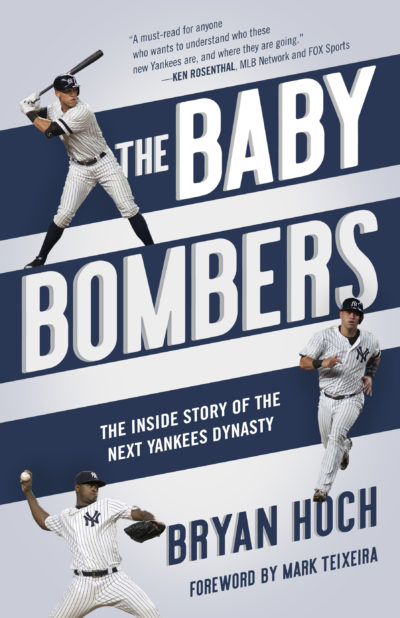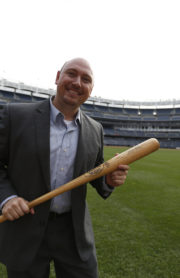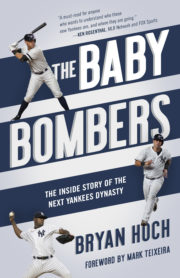
Read an excerpt from The Baby Bombers
The Inside Story of the Next Yankees Dynasty
 Bryan Hoch
Bryan Hoch
The concept of “The Judge’s Chambers” was first floated in the spring of 2017, during a time in which team officials were brainstorming avenues to make Yankee Stadium more appealing to a younger generation of fans. Work had already begun in The Bronx to add children’s play areas, terraces, and party decks to the facility, which was readying for its ninth year of service. Noting the popular response that Aaron Judge had received during the exhibition games in Florida, the Yanks’ decision-makers deemed a dedicated cheering section to be a logical next step.
Similar concepts had been successful in other ballparks, such as the Astros’ “Keuchel’s Korner” for ace Dallas Keuchel and the Mariners’ “King Felix’s Court” for standout pitcher Felix Hernandez. It may not have been groundbreaking, but it seemed that way for the Yankees, a team that often had to fight the temptation of simply leaning upon their storied history to sell tickets. Though some would argue that there had never been a special section devoted to Derek Jeter or Mariano Rivera, the willingness to innovate represented a refreshing change of pace.
Judge told the Yankees that he thought the idea was “cool,” but first, he had to actually make the team. It may seem difficult to believe in hindsight, given how sensational Judge’s rookie season turned out to be, but there was legitimate consideration given to having Judge begin the season in the minors. Since Judge still had minor league options remaining and Aaron Hicks did not, the Yankees decided to carry Judge on the roster only if he won the starting right field job, believing that a backup role would stunt his development.
“He never had a full year in the big leagues,” Cashman said. “He had competition that was legitimate with Aaron Hicks. Aaron Hicks had performed just as well for a period of time, if not better, for the first half of the spring. It was a tight competition. I’d say halfway through camp, Hicks was winning by a hair.
Driven to convince management that he was ready for the opportunity, Judge said that he locked his focus upon having quality at bats for thirty days straight. The organization held daily meetings in the final weeks of camp, with Cashman, Tim Naehring, and numerous other assistants disappearing into Girardi’s office. Judge ignored their lengthy chats, saying that he couldn’t afford to waste time worrying about whether he would begin the season as a RailRider or a Yankee.
“I wasn’t getting paid enough to make that decision,” Judge said. “I had one goal in my mind, to go out there and compete and do whatever I can to fight for a job. Every day I was just taking that mindset, I’ve got to go out there and work my butt off to get this job.”
Seven minutes after 10:00 on the morning of March 30, the heavy steel door to the manager’s office swung open, indicating that a decision had been made. Someone joked that it reminded them of the clouds of smoke that rise over the Sistine Chapel to announce the selection of a new Pope. Girardi summoned the team’s beat reporters and lauded both Hicks and Judge for making it a very tough call, but announced that Judge’s late-spring surge had tipped the scales in his favor.
Hicks took a couple of days to stew over the decision, and though he was disappointed with the outcome, he acknowledged that the team had given him a fair shot. The job had been given to the man who had played the best.
“The last two or three weeks of camp, Hicks didn’t necessarily lose it as much as Judge took it,” Cashman said. “Those weren’t false conversations. It was more like, you’ve got to win that everyday job or you’re going to Triple-A, and Judge knew that. Aaron Hicks is an above-average right fielder in this game, but Judge has turned out to be an MVP candidate. It was real. I guess we made the right decision.”
Judge, meanwhile, was elated. He responded by saying that “now the real work starts,” adding that the challenge would be to ward off the competition from Hicks and the team’s stable of talented minor leaguers. Girardi said that the Yankees were now locked in and would give Judge plenty of leeway if he got off to a slow start. With the Yankees about to open the regular season, Judge called his folks in California, urging them to hop on the next flight to Florida.
“They were worrying about it, just like any parent would,” Judge said. “They just wanted to know what was going on, so I just called them and let them know, ‘Hey, I’ll be in Tampa on Opening Day.’”
Judge was one of five players on the Yankees’ active roster who participated in their first big league Opening Day, joined by Gary Sanchez, Greg Bird, Jonathan Holder, and Bryan Mitchell. Judge hit eighth in the season opener and opted to settle into an art deco hotel in the heart of Times Square, living out of two suitcases between road trips. It was the same hotel where the Yankees had sent him after his first big league call-up the previous August.
“I didn’t know where else to live,” Judge said. “This is my first go-round, so I just kind of thought, ‘I’ll live in New York.’ It was just busy. There were a lot of things going on. That was probably the first thing I noticed when I came here, especially from a small town in California. Then you come here, and usually on the sidewalks back home there’s nobody on the streets. Here, you’re shoulder to shoulder with people.”
Judge’s plate appearances quickly became the ones that no one wanted to miss, easing traffic at the concession stands and the stadium lavatories. Judge tied a major league record by hitting 10 home runs in April, and the top spot in the books would have been his alone if not for an April 16 drive against the Cardinals that was inexplicably credited as a fan-interference triple.
“Last year was kind of like a practice test,” Judge said. “I saw the league a little bit, got a chance to face some pitchers. Now I’m seeing some familiar faces and just getting used to the league, going out there and trying to compete and just keep continuing to have quality at bats.”
Hitting them high, far, and often, Judge quickly won over a fan in Matt Holliday. After Judge homered twice in a 14–11 slugfest victory over the Orioles, the fourteen-year veteran gushed that he thought Judge was “probably the most gifted baseball player I think I’ve ever been around.” That was no small compliment, considering Holliday had shared a clubhouse with Albert Pujols for four seasons in St. Louis.
“You just look at the guy in batting practice and he hits the ball 550 feet,” Holliday said of Judge. “He can run and he can throw at six-foot-seven, 280 pounds. You just don’t see it. I haven’t seen anything like it. It’s fun to watch. He’s fun to watch. I think the whole stadium stops when he comes up to bat. That doesn’t happen all the time.”
When Nick Swisher stopped by Yankee Stadium in a new role as an analyst for FOX Sports, Judge’s former minor league teammate and Waffle House dining companion marveled at how far the slugger had come in such a short period of time.
“He’s a whole different player now than he was at Triple-A,” Swisher said. “He’s got a new stance, he’s got a new swing. Everything has changed. He went home in the offseason and I think what really got him was when he missed those last few weeks of being up here in the big leagues. When he left here, I know that man went home and busted his tail to get ready for this year. He knew that once this season came around, this was his shot.”
Exit velocity was the new buzzword for hitters around Major League Baseball, and the Yankees had started displaying those miles per hour readings in the top right corner of the center-field scoreboard, as they would for a pitcher’s velocity. It did not take long for Swisher and any other observer with eyes and ears to realize that Judge’s thirty-five-inch, thirty-three-ounce Chandler bat was impacting the ball more loudly than any other in the league.
“I’ve never seen anybody hit a baseball like that,” Swisher said. “He’s the red circle in the lineup now. Guys don’t want him to beat them, but this man hits pop-ups for home runs.”
Judge’s mighty strokes were incredible to watch from a safe distance, while unnerving for those who had the misfortune of standing sixty feet and six inches away. Pitching for the Rays, reliever Jumbo Diaz surrendered a game-tying single on April 12 that rocketed off Judge’s bat at 116.5 mph, whistling past the hurler’s right ear into center field.
“It was very close. I felt the wind go by my head,” Diaz said. “When I got back, I received a message from my wife. She was a little scared, a little jolted by it. She was just grateful I was OK.”
Judge celebrated his twenty-fifth birthday on April 26 at Fenway Park, where he had captured the Yankees’ attention a few years earlier with that memorable batting practice session in a Cape Cod League showcase. The party started quickly, as Judge mashed the first pitch he saw from Rick Porcello over the wall in right-center field for his seventh homer of the season.
***
Judge’s production carried the Yankees early, as he became the youngest player in major league history to hit at least 13 homers through his team’s first 26 games of the season. The only other right-handed-hitting outfielder of any age to accomplish that feat had been Hall of Famer Willie Mays, who did it for the Giants in 1964.
It was during this time that Judge received a call from Mike Batesole, his baseball coach at Fresno State. Having once been a high school teammate of Lenny Dykstra and a scout league teammate of Darryl Strawberry, Batesole told ESPN that he wanted to make sure that the temptations of New York City weren’t having a negative impact on Judge.
“On his first day off this year, I said, ‘Look, dude. Bars across America are full of guys who had one good month,” Batesole said. “‘You haven’t done anything except piss the rest of the league’s pitchers off and now they all want you extra bad.’ You’re better off shutting your phone off. Get some alone time, call Mom, give thanks. I don’t want to hear that you had dinner with Jay-Z and Beyoncé on your first day off. Make sure you’re keeping your feet on the ground and taking care of business. His response, as it always is, was, ‘Yes, coach.’”
The national media enthusiastically embraced the storyline of a hulking Yankees superhero with an aw-shucks demeanor. A May 15–22, 2017, double issue of Sports Illustrated featured Judge on the cover, depicting his mighty pinstriped cut behind the words, “All Rise! The Yankees’ Youth Movement Is in Session. The Powerful Aaron Judge Presiding.” Stephanie Apstein’s accompanying article traced Judge’s roots, painting Judge as a shy rookie from a small California town whose career happened to be off to the most prolific start ever.
The next week, NBC’s The Tonight Show aired a hilarious segment in which Judge tested his acting chops with his best Clark Kent impression, donning a blazer and glasses behind a desk in New York’s Bryant Park to quiz Yankees fans about…Aaron Judge.
After asking one fan how much he thought the rookie might be able to bench press, Judge nonchalantly replied, “400? You’re right.” One fan referred to the prospect as “Adam Judge,” and another passerby wearing a Yankees jersey figured out the gag when Judge held up his SI cover, offering a double take before taking note of Judge’s toothy smile.
“It was the gap,” he said. “There’s only two gaps in New York, you and [Michael] Strahan, man.”
The Yankees were visiting Kansas City the day after that segment aired, and Judge said that his phone had been overwhelmed with text messages and voice mails. Judge had tipped off his parents to the upcoming bit, asking them to set their DVRs, but the late-night appearance had come as a surprise to most of Judge’s friends and family.
“I’m not really a comedian at all, but I think it turned out great,” Judge said. “I was nervous the whole time. When I was going through it, I didn’t think I was doing well at all. They did a lot of editing and it really turned into something great.”
When several groups of fans began attending games in black robes and white powder wigs, waving signs that included variations of “All Rise,” the Yankees responded by unveiling the project that they had discussed during the spring. When the Yankees took the field for batting practice on May 22, The Judge’s Chambers appeared at the rear of Section 104 in right field, eighteen seats boxed in by wood to create the appearance of a courtroom jury box.
New York versus Kansas City was first on the docket. It would only be Judge’s sixty-sixth major league game, but Jason Zillo, the Yankees’ director of media relations, said that the Judge’s Chambers had simply continued the momentum that the fans established on their own.
“It’s all part of a shift toward making the experience more interactive,” Zillo said. “It’s a different era. It’s a different group of fans. Fans are looking for things in their trip to a stadium that fans weren’t looking for ten years ago, twenty years ago, thirty years ago.”
The seats became a wildly popular attraction, with fans lining up early for the opportunity to snap selfies in the area. Fans flooded the team’s ticket office with inquiries about the section and were told that they could not buy their way into the Judge’s Chambers; instead, Yankees employees roamed the concourses prior to first pitch, looking for fans who were wearing Judge paraphernalia and offering them the opportunity to upgrade their seat location.
Upon entry, fans were issued black robes with the Yankees logo on the front and Judge’s No. 99 on the back, as well as foam gavels. The gavels (also sold in stadium gift shops) were theirs to keep, but the robes were washed and re-issued for the next home game. On one occasion, Associate Justice of the Supreme Court Sonia Sotomayor spent a few innings in the Chambers, cheering along with her fellow Yankees fans.
“It’s pretty unreal,” Judge said. “I never would have thought [this could happen] so soon. But the fans like it, so I’m glad they’re having fun.”
Named the American League’s Rookie of the Month in both April and May, Judge was the first Yankee to ever win the award twice in a season and the first Yankee since Don Mattingly in 1985 to win any monthly award in consecutive months.
***
To find out more click the link below
The Baby Bombers: The Inside Story of the Next Yankees Dynasty

